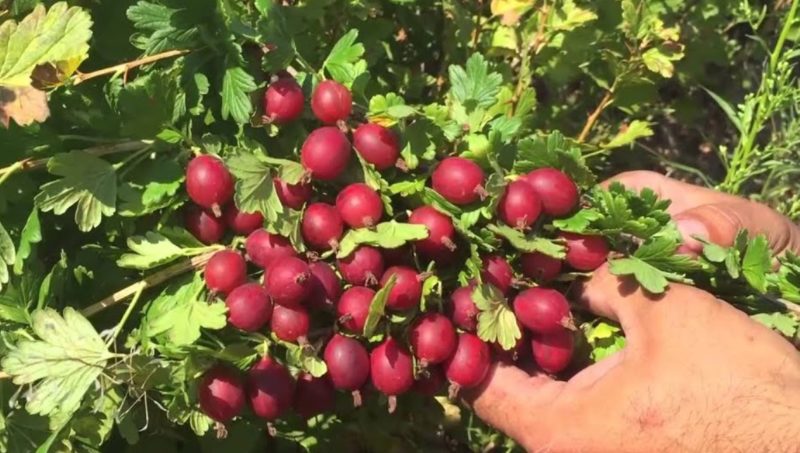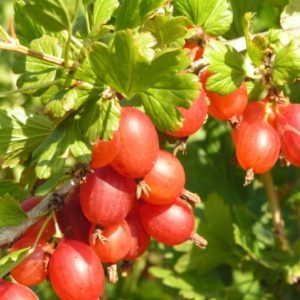High-yielding frost-resistant gooseberry variety Masheka
The gooseberry variety Masheka is one of the favorites among experienced gardeners. It is appreciated for its stable yield and pleasant fruit taste. It is not difficult to grow it, and the area of distribution is very extensive due to the culture's ability to withstand severe frosts.
The content of the article
Features of the gooseberry variety Masheka
Masheka gooseberry is a self-fertile high-yielding variety with good winter hardiness and drought resistance.

History of origin and distribution
The variety was bred by Belarusian breeders in 1997 by crossing the varieties Confection and Houghton. Due to the average ripening period of the fruit, the Masheka gooseberry is intended for cultivation in the central region of Russia. However, he is able to please with fruiting in more climatically harsh areas with additional shelter or in greenhouses.
Characteristics and description of the bushes
Bushes of medium height, with a spreading and dense crown. Shoots grow with a slight slope, medium branching. The bark of the branches is light green, with medium-thick yellowish-brown thorns on it.
The leaves are dark green, wrinkled and leathery, with teeth bent to the inside. Inflorescences are small, two-flowered.
Resistant to temperatures
The Masheka variety tolerates low temperatures well and is not afraid of frosts. Do not be afraid of indicators at -30 ° C, and with additional cover, the bush will withstand -35 ° C.
Moisture and drought resistance
For full growth and timely fruit set, Masheka gooseberry needs regular watering. The root system of the shrub does not like stagnant water, so it should not be planted in lowlands and swampy areas.
Disease and pest resistance
The variety is famous for its strong immunity to many diseases and is not afraid pests.
Characteristics and description of fruits

The berries of this variety are orange-red, without edges, medium in size and oval. At the highest stage of maturity, the fruits become brick-red. Their taste is sweet and sour, the pulp is very juicy, with a lot of seeds. Tasting score - 4 points out of 5.
Areas of use
Jam and compotes are made from gooseberry fruits, jams and confitures are made. However, they are most useful fresh - they contain a lot of vitamins and trace elements, which are destroyed during heat treatment.
Advantages and disadvantages compared to other varieties and hybrids
The main advantages of Mashek gooseberries over other varieties:
- frost resistance;
- good harvest indicators (up to 6 kg of berries from one bush);
- self-fertility;
- transportability of fruits;
- strong immunity to many diseases and resistance to most pests.
There are few disadvantages of this variety. Despite its frost resistance, it develops and bears fruit better in warm climates. Unfavorable conditions during the season reduce yields and interfere with the growth of root growth necessary for reproduction.
Growing technology
By following simple rules for planting and caring, you can achieve high yields for up to 18 years.
Optimal conditions
The site should be chosen well-lit, with protection from the wind and a high occurrence of groundwater (but not higher than 1.5 m). Loose fertile soil with a low pH level is required.
In the sandy soil in the year of planting, humus or compost is introduced (10 kg for each seat). Clay soil requires a combination of organic fertilizers and sand. The acidic soil is treated with lime or dolomite flour.
Terms and rules of landing
It is best to plant gooseberries in the fall, about 3-4 weeks before the first frost. In this case, the seedlings have time to take root and will be able to successfully overwinter. You can plant it in the spring, but you need to ensure regular watering.
The planting process differs little from planting other shrubs:
- Dig up the soil, removing the remnants of the roots of weeds, stones and branches.
- Holes measuring 50 × 50 × 50 cm are dug at a distance of 1.5 m from each other.
- The soil is mixed with mineral fertilizers and organic matter.
- The seedling is placed in a hole, the roots are lightly pressed and covered with earth.
- The earth is compacted and watered. Peat or humus is distributed from above.
Further care
Mashek gooseberry is a drought-resistant crop, however, to obtain a rich harvest, it is necessary to ensure regular watering throughout the spring. It is best to use a sprinkler method or supply water through small grooves. Two weeks before the berries ripen, watering is paused to avoid the sour taste of the fruit. The last time the bushes are watered before wintering.
Gooseberries need annual pruning for consistently high yields. The first few years cut off all unnecessary shoots, leaving only 3-5 of the most developed. The mature plant is regularly checked for weak and broken twigs.
Top dressing is carried out in the fall, every 2-3 years. The best way is to mix 6 kg of organic matter, 100 g of wood ash and 20 g of superphosphate. In the spring, gooseberries are fertilized with ammonium nitrate (15 g per 1 sq. M).
Possible problems, diseases, pests
Of the diseases, the greatest danger to the variety is represented by such diseases as septoria, anthracnose and powdery mildew. To avoid diseases, gardeners in early spring, after the snow has completely melted, shed boiling water around the bushes. Immediately after that, the plants are sprayed with 1% Bordeaux mixture. When the bush is affected by these diseases, the damaged shoots are cut off and burned, after which the treatment with the Bordeaux mixture is repeated.
For protection from harmful insects gooseberries are treated with insecticides at the beginning of the season.
Wintering
The variety easily tolerates the effects of negative temperatures, so there is no need to cover it for the winter. If there was little rain in the fall, the shrubs are provided with water-charging irrigation, which allows the soil to retain heat for a long time. With little snow, but frosty winter, the bushes are covered with a thick layer of snow and left in this form until spring.
Reproduction
The variety gives a lot of root growth. In the spring, you can dig out several one-year or two-year shoots, on which 3-4 swollen buds have already formed, and plant them in a previously prepared area.
The variety is effective breeds by digging in shoots. In early autumn, shallow ditches are dug around the trunk, into which several branches of the bush are lowered. They are sprinkled with a small amount of earth. To form a root system in the shoots, they are periodically watered. In autumn, the finished shoots are separated from the mother plant and transferred to containers with peat. By spring, the shoots will be completely ready for planting in the ground.
Features of cultivation depending on the region
Mashek gooseberries do not require special attention in warm regions with rainy autumn and not very dry summer. But in the central regions, it is important to keep track of soil moisture in time and properly prepare the bushes for wintering.
If the plant is grown in more severe climatic conditions, it is protected with additional shelter and protected from adverse weather conditions. However, one should not count on a rich harvest in such regions.
Pollinating varieties
The variety is self-fertile, that is, it does not need pollinators to set fruit.
Reviews of summer residents

Reviews about Mashek's gooseberry are mostly positive. Gardeners note the sweet taste of berries, resistance to frost, diseases and pests.
Tigunov Victor, Novosibirsk: “On my site I grow several varieties of gooseberries, among them is the Masheka variety. The berries are juicy, sweet, children and grandchildren eat with pleasure. We harvest at the end of summer. Of the significant drawbacks, I can note the need to regularly thin out the bush - before the buds appear, a little in summer and autumn before wintering. For the winter I cover the bushes with sacking and fall asleep with snow, for 10 years I have never frozen, it bears fruit steadily. "
Vybornova Inna, Obninsk: “I planted the seedlings of this variety in the spring, the bushes took root and gave a harvest in the second year. For several years, the gooseberry did not get sick and did not freeze, tolerating severe frosts perfectly. In the summer, I install a support for the branches - under the weight of the berries, they sink to the ground itself. We start up the harvest for jam and compotes, we eat some fresh. "
Conclusion
The Belarusian gooseberry variety Mashek has many advantages. Due to its good winter hardiness, it can be grown in regions with cold winters. It is not afraid of pests, disease resistant, does not require much attention. Summer residents say that it is easy to get a stable harvest every year, it is enough just to regularly water the bushes and cut off unnecessary shoots in time.